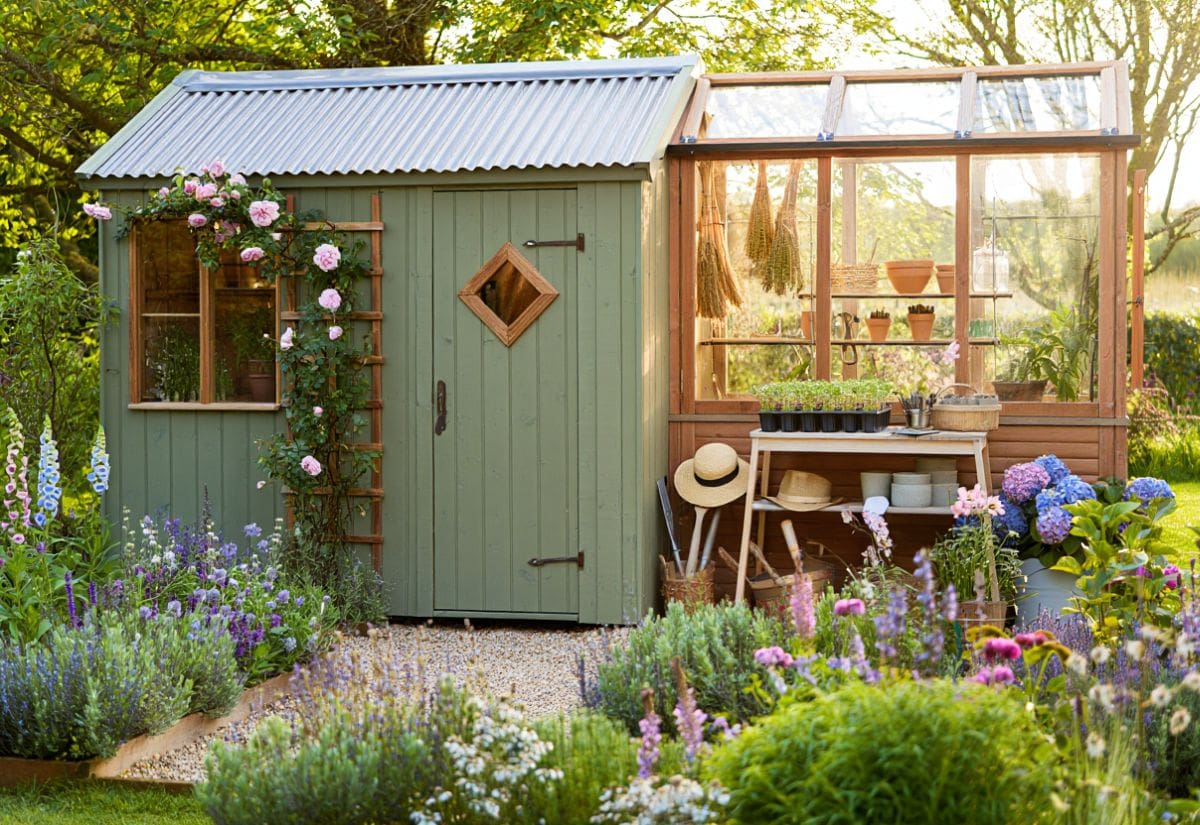
Not every garden needs a shed—but once you have one, it’s hard to imagine the space without it.
It might start as a place to keep tools, a stack of pots, or a few bags of compost. But somewhere along the way, it becomes something more—a backdrop for blooms, a quiet corner to think, a space that gives the whole garden its rhythm.
Some sheds feel like secret hideaways, with climbing roses brushing the windows and thyme spilling over the edges of the path. Others are sleek and modern, painted in dreamy sage green or bold black, framed by borders of lavender and salvia. Whether rustic or refined, cottagecore or contemporary, a well-designed shed always seems to say: this space is loved, and it’s meant to be lingered in.
Over the years, I’ve seen how a great shed becomes the heart of the backyard. It anchors the garden—not just visually, but emotionally. It sets the tone, pulls everything together, and often becomes the spot where the most meaningful moments happen. A place for potting soil and seed packets, yes—but also a place for quiet thinking, scribbled ideas, or a stolen cup of tea in muddy boots.
In this collection, you’ll find 30 inspiring garden shed design ideas that do exactly that. Each one blends structure with softness, beauty with function, and charm with intention. Some are tiny greenhouses or floral studios. Others feel like cozy reading nooks wrapped in vines. But all of them offer something a little special—and a whole lot of soul.
1: White Garden Shed with Lavender Tools and Purpose
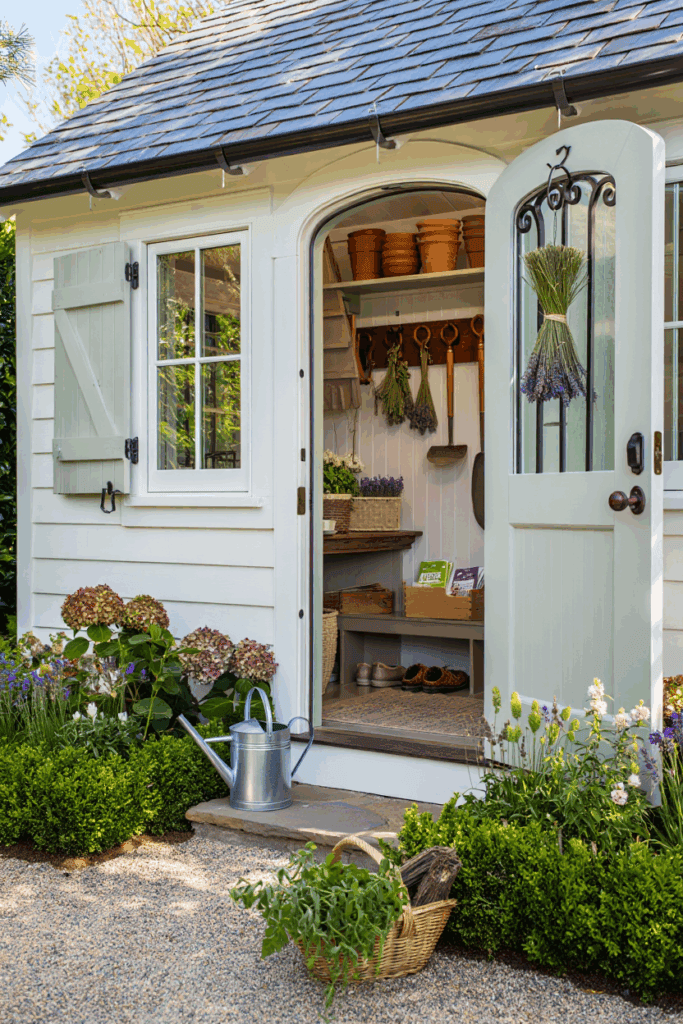
For a hardworking garden that still leans romantic, I often reach for white-painted sheds with subtle green doors—especially when they sit in full sun. This space balances order and charm: dried lavender bundles act as both decor and natural moth deterrents, while old garden tools hang ready on shaker pegs. I always encourage tucking a bench inside for early morning seeding or rainy-day tasks. Outside, try pairing neat boxwood hedging with faded summer hydrangeas and silvery perennials like catmint or lamb’s ear. It’s functional, fresh, and fragrant—just the kind of place that keeps you grounded in the season’s rhythms.
2: Round Stone Shed Retreat with Meadow Path
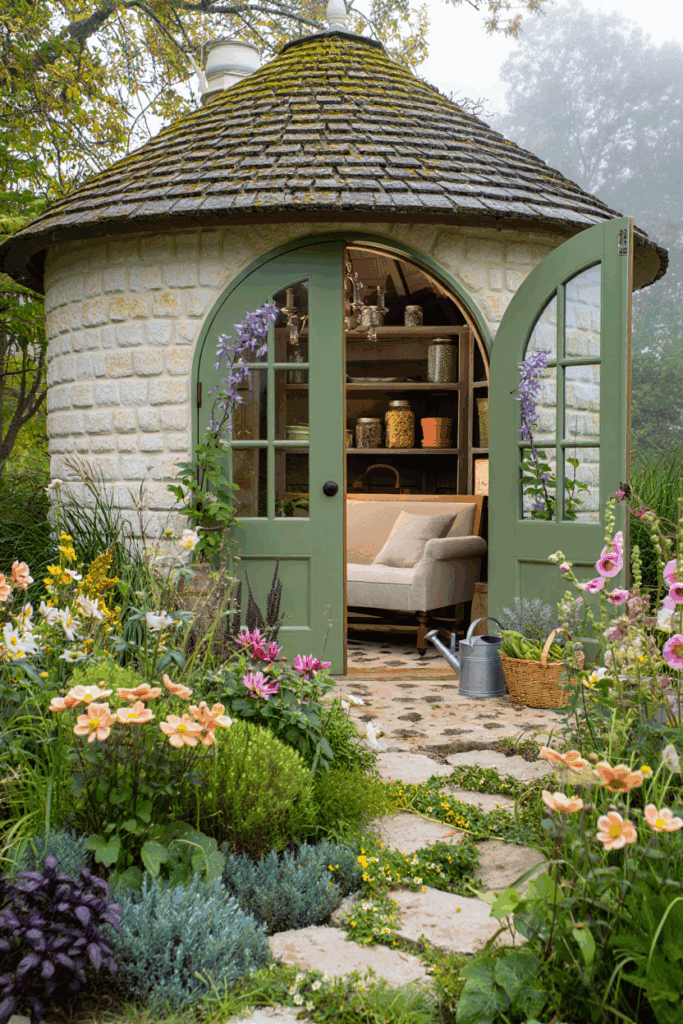
When a garden needs a touch of storybook magic, I recommend a round stone shed like this one. It has a softness to it—thanks to the mossy roofline, sage-green doors, and curved lines that draw you in. I love planting soft climbers like clematis or sweet peas right at the doorway to break the formality and add seasonal life. Inside, a cozy chair and wall shelving make it a true retreat—perfect for herb jars, seed packets, or just sitting with a journal. I often design winding stepping stone paths to lead up to these kinds of structures, using meadow-style plantings to blur the edges. It feels less like a shed, more like a secret kept by the garden.
3: Beige Shed with Lavender Borders and Quiet Structure

In wide, open gardens, I often choose soft neutral tones for the shed—something like warm beige or weathered taupe. It lets the planting speak without losing presence. I start the layout with loose stepping stones, then build out with reliable border plants: low drifts of lavender for texture and scent, dotted with summer yarrow and airy cosmos to catch the light. I like including a freestanding chair or crate outside the shed—it offers a spot to pause and draws the scale down so the shed feels welcoming, not stark. The door should have glass to let in light, and inside, keep things simple: a few clay pots, a hanging apron, and tools along the side wall. It’s the kind of setup that brings beauty to the everyday.
4: Storybook Shed Framed by Cottage Blooms
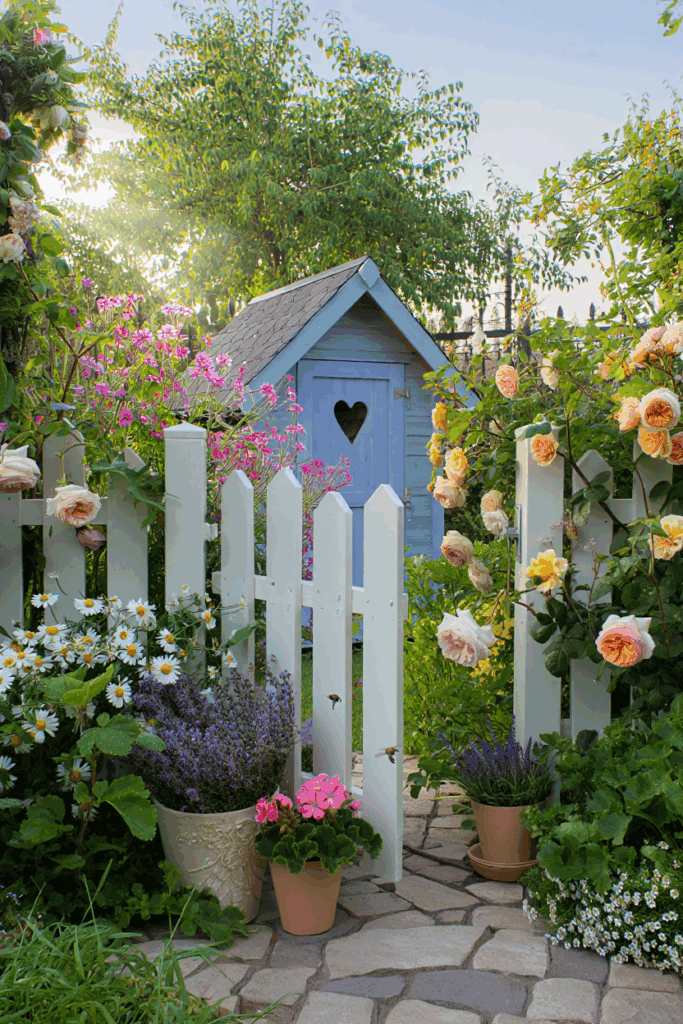
For whimsical spaces with a nostalgic pull, I like to combine upright shapes like white picket fencing and tight clipped hedging with just the right amount of garden exuberance. This little blue shed—with its heart-shaped cutout and cottage roof—becomes a fairytale moment when surrounded by blooms that feel loose but still intentional. I recommend English shrub roses like ‘Crown Princess Margareta’ or ‘Lady of Shalott’ for those warm apricot tones, paired with the innocence of oxeye daisies or Shasta ‘Becky’. For layered softness, tuck in potted lavender (‘Hidcote’ for cooler tones or ‘Grosso’ for fragrance) and trailing bacopa or sweet alyssum along the edges. Don’t be afraid to use classic pink geraniums in pots—they pop cheerfully and help bridge modern and vintage tones. For pathways, I prefer irregular flagstone set into thyme or creeping chamomile—it holds the space loosely and smells divine when walked on. Framing the entry with climbing roses or even thornless blackberry vines can also add height and seasonal drama.
5: Glass Greenhouse Shed with a Working Edge
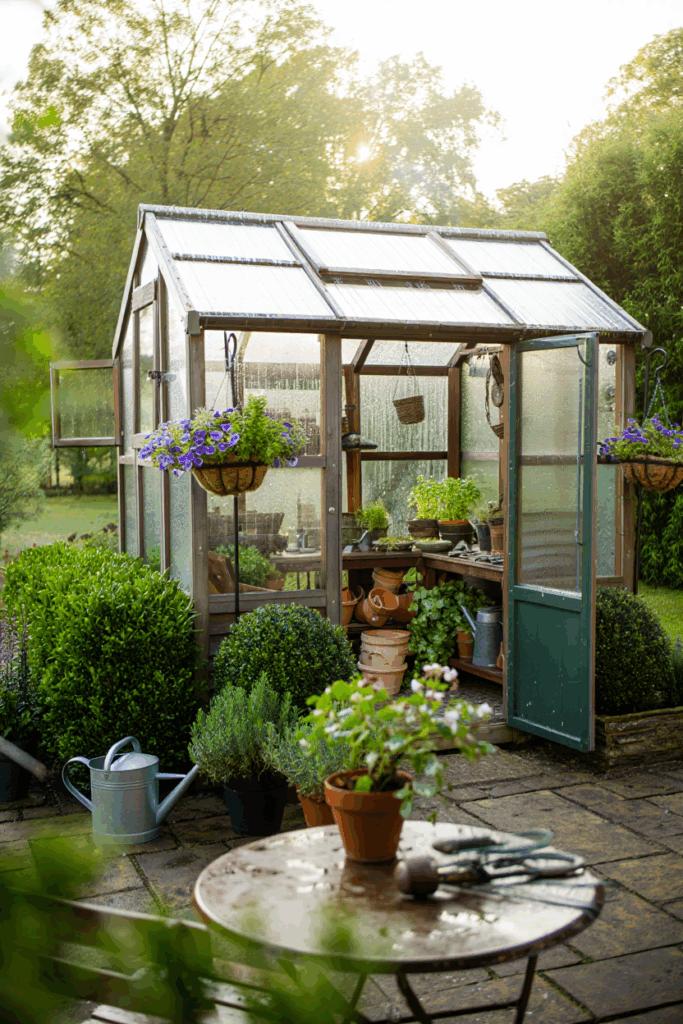
Greenhouse-style sheds are perfect when you want structure and softness in the same space. I use clear rooflines for light, but keep the sides a mix of glass and frame to avoid overwhelming the space visually. The entry matters here—gravel or reclaimed brick feels warm underfoot and keeps mud at bay. I often design the surrounding beds with low, evergreen anchors like boxwood or dwarf rosemary, then layer in hanging baskets with trailing nasturtiums or pelargonium to bring the eye up. This structure works best when the interior is active: stacked clay pots, seed trays, and a wide prep bench. Let it feel used—it’s the working heart of the garden, where mess is part of the beauty.
6: Woodland Garden Shed with a Deep Blue Palette

In shaded gardens, I often use darker shed tones like charcoal, navy, or midnight blue to create a sense of depth and drama. This muted backdrop allows spring ephemerals—like daffodils, grape hyacinths, and muscari—to shine with clarity and vibrancy. The curved stepping stone path softened with moss underfoot provides a grounded rhythm through the space and encourages slower movement. Surrounding beds are filled with long-established bulbs and shade-tolerant groundcovers, layered to mimic how plants naturally grow in woodlands—drifting, overlapping, and textural. An Adirondack chair and urn add structure to the porch, anchoring the composition with human scale and functionality. I often tuck in accessories like baskets or watering cans here—they soften the hard edges and reinforce the feeling of a working retreat.
7: Thatched Garden Shed with Wildflower Meadow Energy

This shed is a masterclass in blending wild beauty with nostalgic charm. The thatched roof introduces texture and whimsy, while the vertical wooden cladding painted in a pale sage green offers a rustic softness that feels lifted straight from an old-world farmstead. Around it, I’ve built a spontaneous-style meadow with tall spires of foxglove and lupine, interspersed with goldenrod, shasta daisies, and lavender. The color palette feels joyful yet balanced—purples and pinks playing against warm whites and yellows, unified by a shared softness in tone. The informal stone path is key here—it weaves gently through the garden like a natural track through a meadow, inviting you forward without imposing structure. Let plants flop, self-seed, and mingle freely. This is a scheme where imperfection is part of the design story.
8″ French-Inspired Potting Shed with White Flowers and Rustic Texture
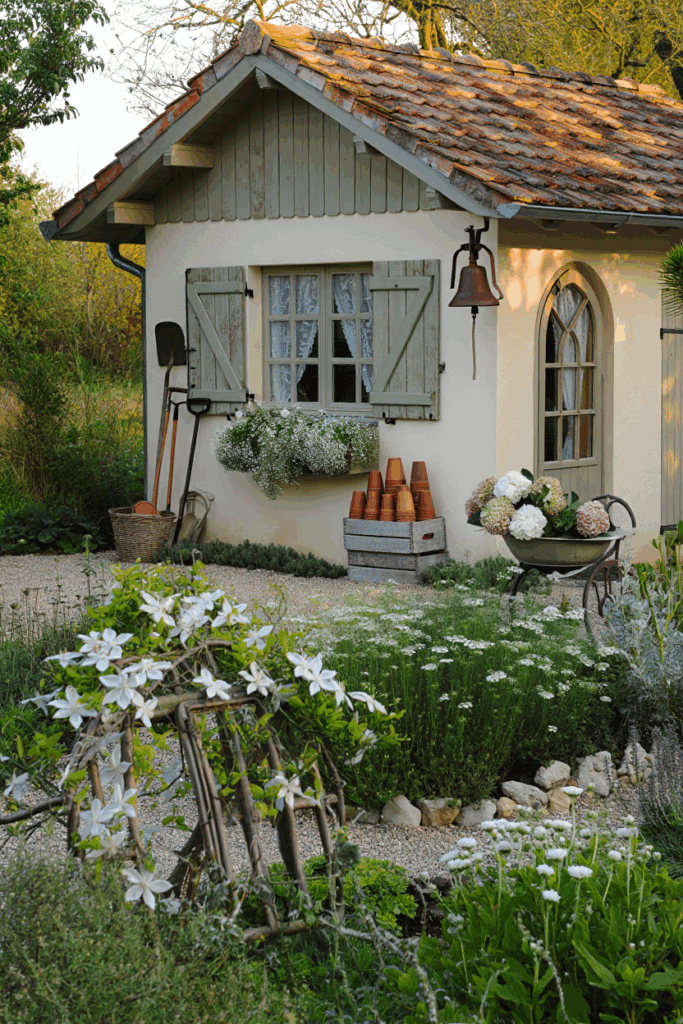
This design leans heavily into romantic utility—the kind of space that’s just as practical as it is beautiful. The cream stucco and red clay tile roof evoke a Provençal aesthetic, softened by sage-green shutters and trailing lace curtains. Window boxes spill over with baby’s breath, echoing the rounded, cloud-like forms of nearby white clematis and Queen Anne’s lace. The gravel ground plane is neutral and warm, keeping the mood relaxed, while a curved border of oregano, lavender, and rosemary frames the foreground. Clay pots, baskets, and weathered tools aren’t afterthoughts—they are styling elements that ground the design and tell the story of a working garden. I recommend tucking in furniture or vintage finds that enhance the narrative. Here, every detail, even the practical ones, contributes to a poetic whole.
9: Rustic French Potting Corner with a Soft Green Palette

A good shed garden doesn’t need flash—it just needs coherence and charm. This one uses aged materials to full effect, with distressed shutters, terracotta pots, and reclaimed crates pulling the scene together. What makes it work is the restrained color palette: soft greens, creamy whites, and wood tones. White hydrangeas in a chipped enamel pot echo the Queen Anne’s lace and alyssum spilling from the planter box, while lavender and rosemary at ground level add movement, scent, and texture. Notice how the shed wall and vertical tools give visual height, balanced by low mounding plants. A gentle gravel path ties it all together, adding structure while feeling casual.
10: Bold Black-and-White Shed with Jewel-Tone Blooms
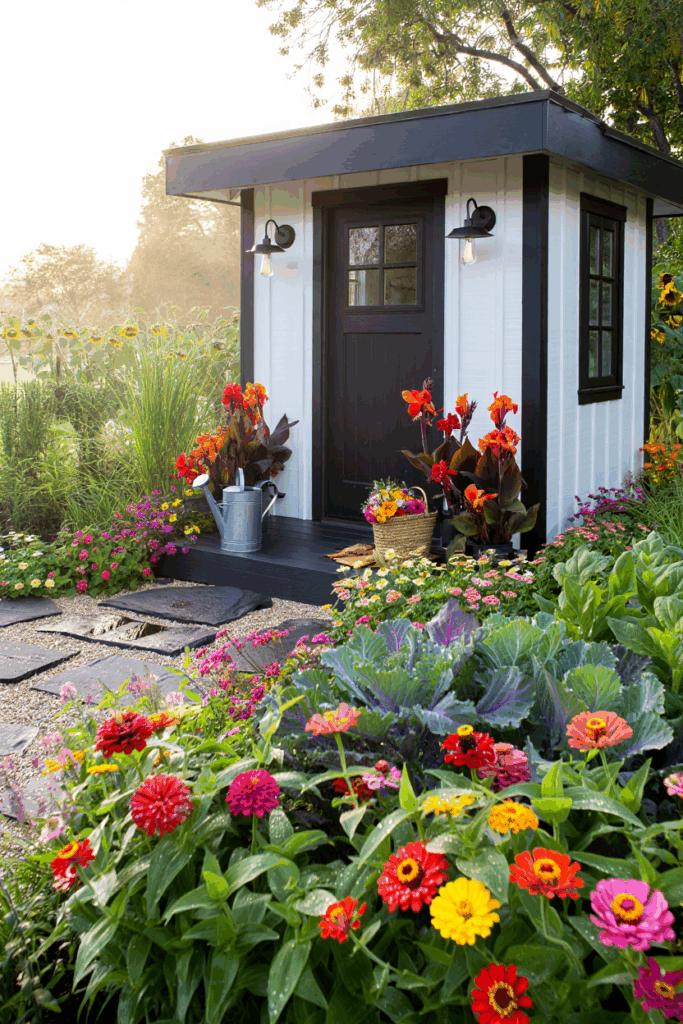
When designing a modern garden structure like this, I like to lean into contrast. The sleek white shed with black trim acts like a canvas for the explosive color around it. Bright red cannas add drama and height, flanked by clusters of zinnias, dahlias, and marigolds in hot oranges, pinks, and yellows. Edging with purple fountain grass and ornamental kale brings shape and unexpected foliage tones. The staggered slate stepping stones offset the grid of the shed, adding movement. Every plant here thrives in full sun and offers long-season bloom or texture, making it not just bold but practical. This space feels joyful—playful, usable, and completely alive.
11: Glass Garden Shed with Hanging Baskets and Formal Hedges
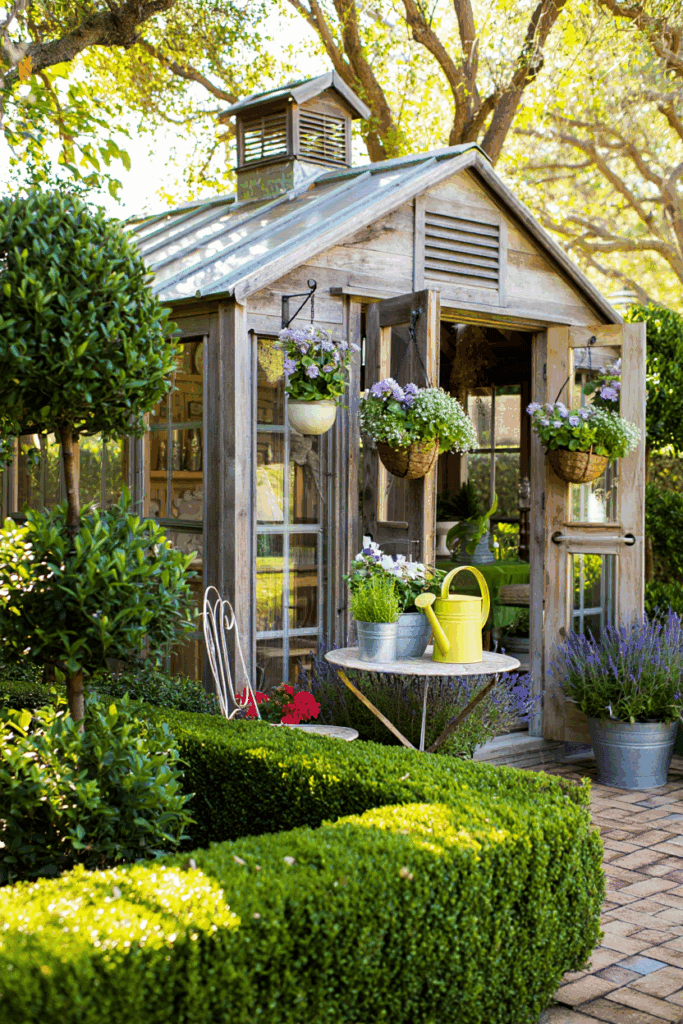
Here, the shed becomes part greenhouse, part jewel box. Its clean verticality and weathered wood tones balance the lush plantings around it. The clipped boxwood hedging offers formal definition, ideal if you want something low-maintenance yet sculptural. For a similar effect, you could use dwarf English boxwood or even compact yew. Use straight lines or clipped U-shapes to define small “garden rooms” around your shed. The gravel or brick patio acts as a buffer between planting and structure, allowing space for movement and light. Layer in fragrant herbs like rosemary, thyme, or dwarf lavender in galvanized containers to soften the lines, and elevate charm with hanging baskets of petunias, verbena, or Bacopa in coconut-lined pots. The shed shines not because it dominates, but because it’s styled like part of the garden—open, lived-in, and productive.
12: Natural Wood Shed Along a Natural Stone Pathway
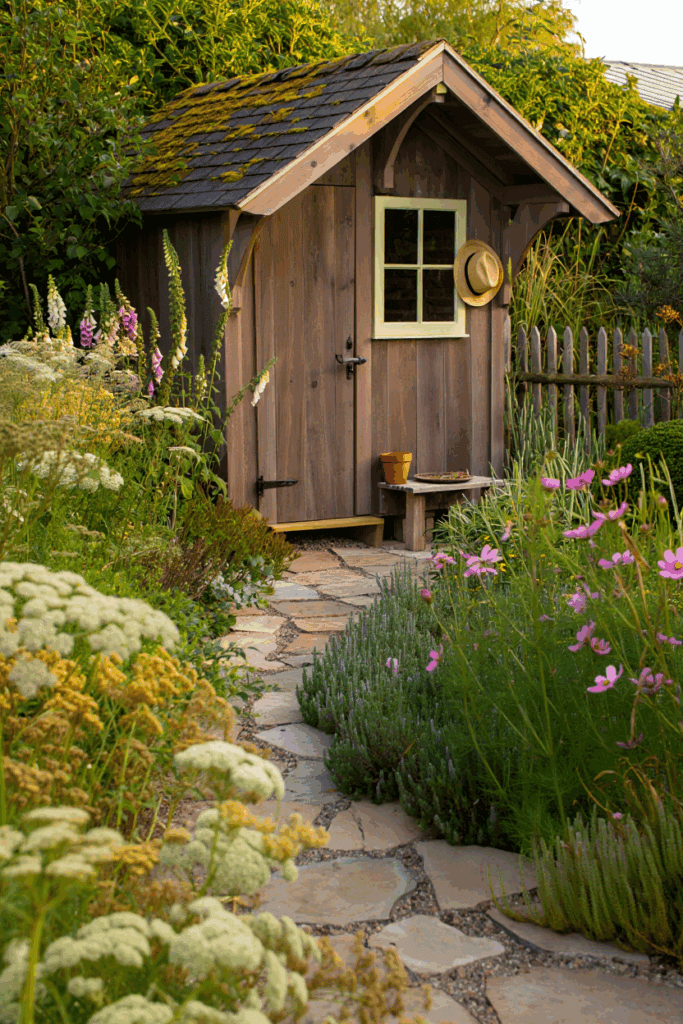
This is a masterclass in blending hardscape and softscape. The shed’s dark-stained wood and mossy shingles feel rooted in the land, while the soft stone path meanders naturally through layers of color and texture. For a similar feel, opt for irregular flagstone or sandstone slabs set into pea gravel. Let your path curve—resist the urge for symmetry—and flank it with textural perennials like Queen Anne’s lace, yarrow (‘Moonshine’ or ‘Coronation Gold’), and cosmos. Add in soft spires like foxgloves or larkspur at the back to draw the eye upward, and ground the scene with mounds of lamb’s ear or creeping oregano at the edges. The planting should feel as if it grew there on its own. The shed isn’t just a backdrop here—it’s the emotional landing point, with its earthy materials echoed by every softly waving bloom.
13: Bold Black Shed with Wildflower Energy
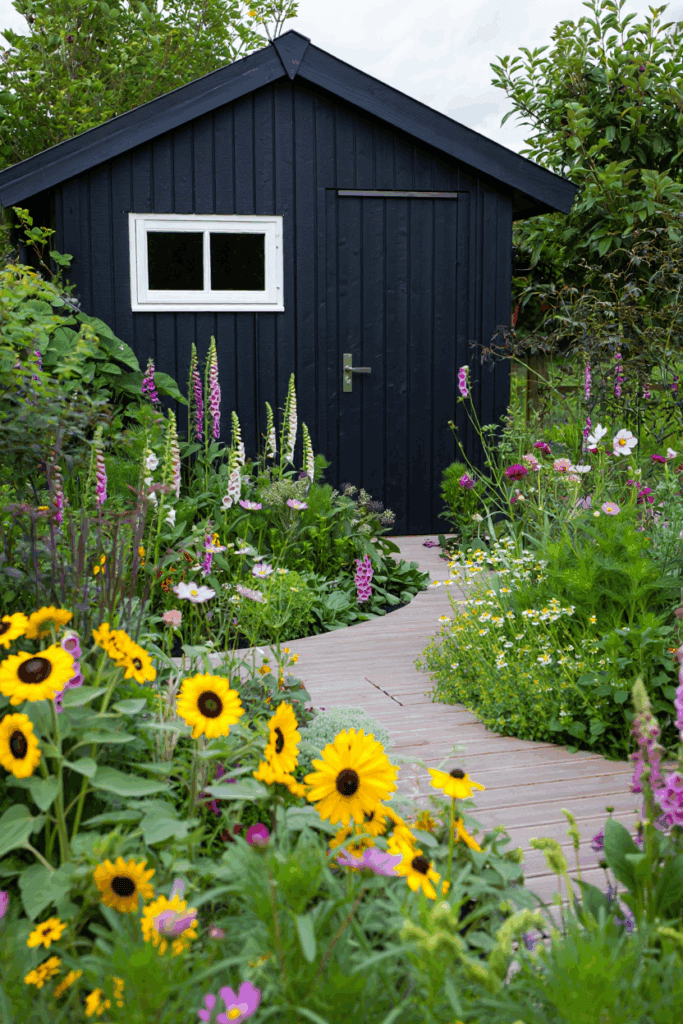
For a soft, airy look, I often start with a shed in pale duck egg or cornflower blue—it cools the space visually and brings out the silvers and mauves in surrounding plants. Here, a layered planting works best: salvia ‘Caradonna’, Nepeta ‘Walker’s Low’, and pink digitalis offer upright movement, while lamb’s ear and creeping thyme soften the path edges. I recommend defining the bed with a gravel or brick edge, and grounding the shed with large ceramic pots filled with lemon balm or dwarf lavender. If shade creeps in, swap the sun-lovers for astrantia, brunnera, and ferns. This structure-and-softness pairing feels like the garden is exhaling.
14: A Sunny Potting Shed with Roses and Painted Shutters
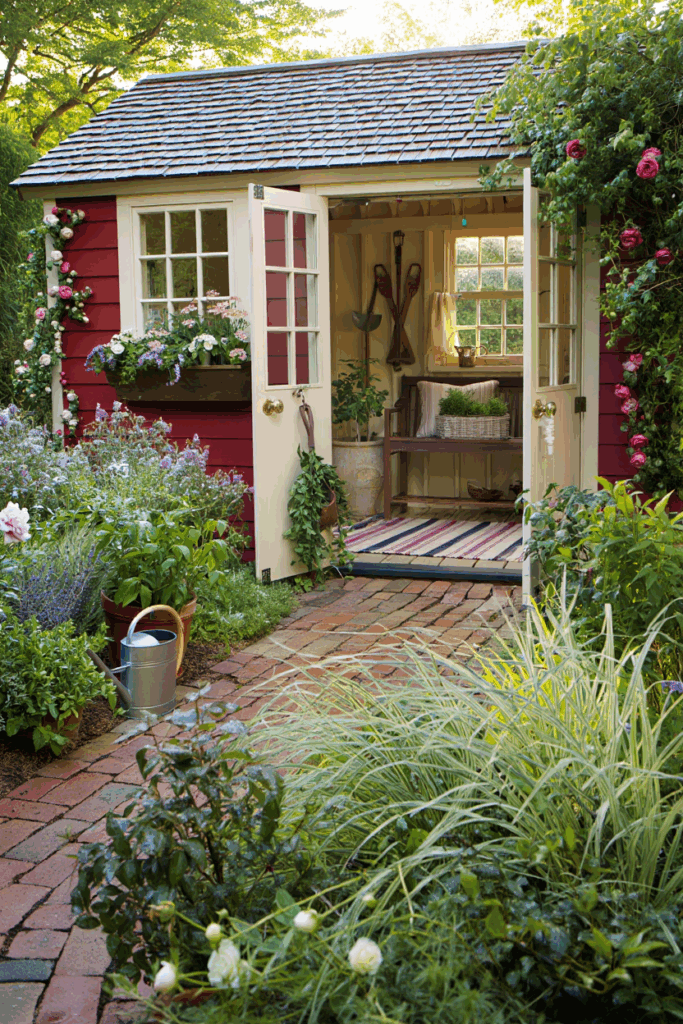
If you’re working with a shed in partial shade or filtered light, I often recommend cream-toned doors and accents to brighten the façade. This shed’s French doors open wide to invite the garden in, and the window trim is softened by climbing ‘Pierre de Ronsard’ roses and pink verbena in rustic wooden window boxes. For a similar effect, pair upright salvia with spreading calibrachoa or ‘Powder Puff’ lavender for a mixed height and texture display. The interior is styled like a sunroom-meets-tool station with striped rugs and woven storage—practical but charming. The brick path curves with intention, hugging the planting bed and letting low-growing grasses like ‘Aureola’ hakonechloa spill over the edge. This scene feels both nostalgic and fresh, perfect for gardeners who want a workspace that also lifts the spirit.
15: Classic Cottage Shed Framed in Summer Blooms
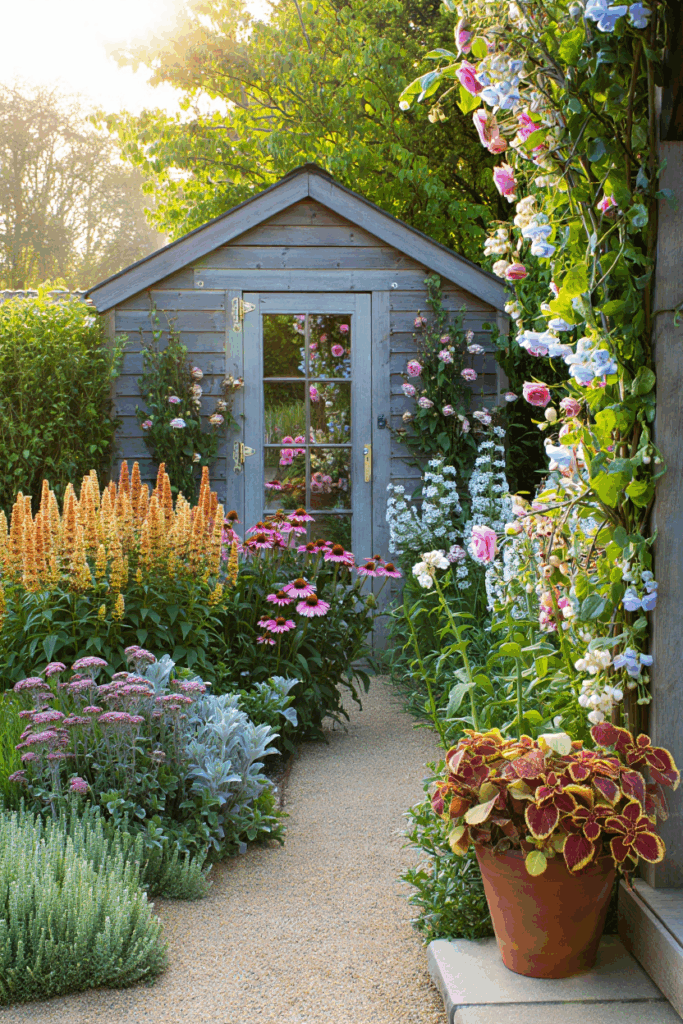
In cottage gardens with structured paths, I often recommend starting with a simple gray-toned shed like this one, then using the surrounding beds to explode with seasonal texture. Coneflowers like Echinacea purpurea offer cheerful height alongside spires of Digitalis lutea or yellow lupines for warmth. I like pairing these with feathery silver foliage—try Artemisia ‘Powis Castle’ or Stachys byzantina (Lamb’s Ear)—to soften edges and cool the palette. Along the doorframe, climbing roses and sweet peas add vertical interest and fragrance; you can also use Clematis montana for a slightly wilder look. Gravel paths edged in lavender or thyme create the rhythm here, drawing your eye naturally toward the shed door like a storybook invitation.
16: Pale Blue Shed with Potted Borders and Lavender Edging
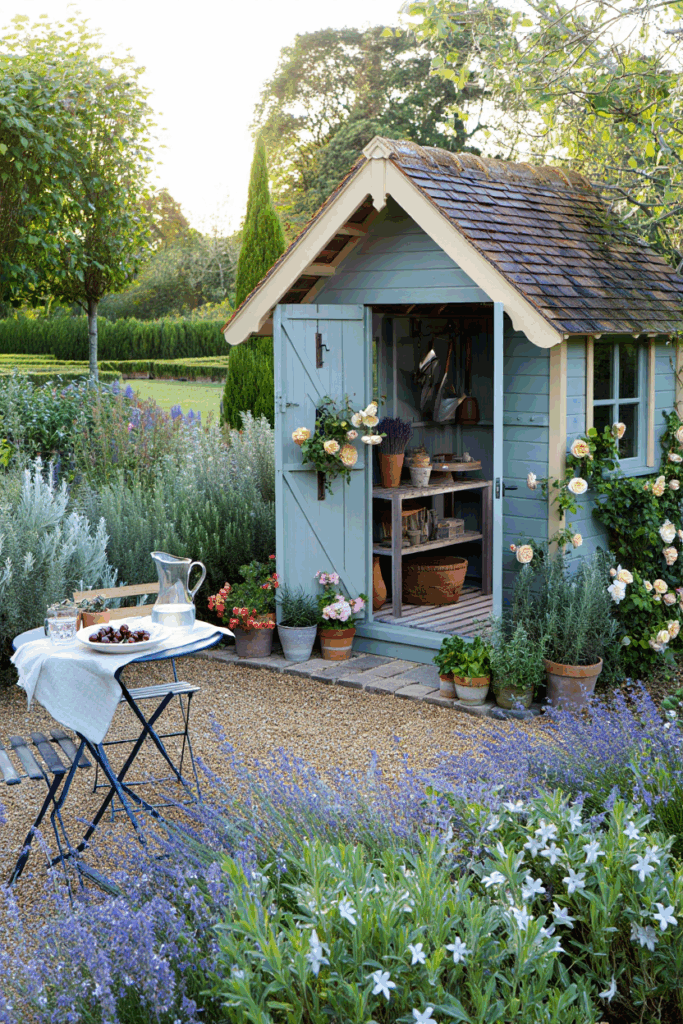
This pale blue shed with cream trim evokes a gentle, relaxed charm that always photographs beautifully in late afternoon light. To recreate this look, I suggest blending structure with softness: edge the base with potted herbs (lavender, rosemary, thyme) in weathered terracotta and let climbing roses like ‘Crown Princess Margareta’ or ‘The Alnwick Rose’ trail gently across the sides. I like to mix in low Nepeta ‘Walker’s Low’ and white Campanula to keep the lavender hedge from feeling too uniform. If you want that patio feel, lay pavers or bricks in a loose border around the threshold, then scatter gravel across the main path to warm the tone. Adding a café table offers not just function but a lifestyle detail—encouraging slow afternoons in the garden.
17: Stone Shed with Wild Meadow-Style Planting
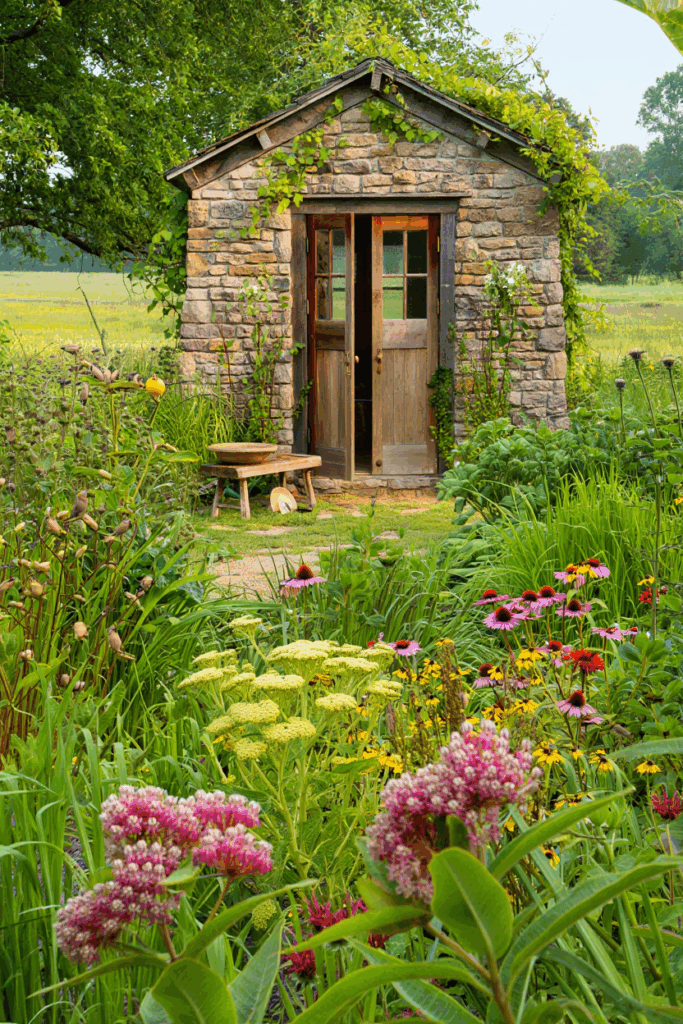
Stone structures like this one are an anchor—they already tell a story. To balance their rustic solidity, I lean into wild, airy planting with a sense of organized chaos. Start with Echinacea purpurea, Rudbeckia hirta, and Asclepias incarnata (Swamp Milkweed) for strong summer color, and mix in Angelica gigas or Achillea millefolium for contrasting shape. Let the edges blur—grasses like Panicum virgatum or Deschampsia cespitosa add movement and soften the transition to meadow beyond. I suggest avoiding rigid borders here; instead, let stepping stones weave naturally through. Add an old wooden bench under a tree for a touch of stillness that balances the wild energy of the border.
18: Green Shed with Bold Lupine and Daisy Border
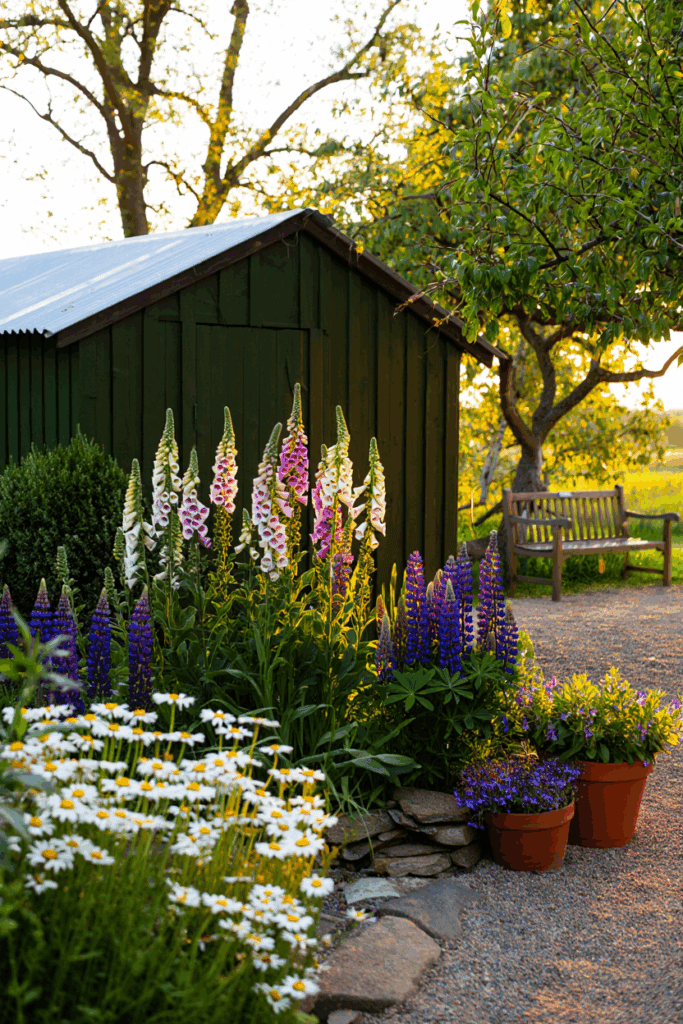
For dramatic contrast, a shed painted in rich green sets the stage beautifully—especially when paired with high-impact bloomers like foxgloves (Digitalis purpurea) and lupines (Lupinus polyphyllus). I love creating a staggered edge by tucking in Leucanthemum x superbum (Shasta Daisy) for softness and Campanula glomerata or Veronica spicata for rich blue tones. Terracotta pots filled with Lobelia, Nemesia, or Calibrachoa can be placed casually near the foundation, echoing the vertical lines of the flowers while softening the shed’s footprint. A well-laid gravel path edged in stacked stones or river rock helps tie everything together. If you’re working in strong light like this, consider how shadows and bloom silhouettes interact—it’s a painterly balance.
19: Lavender Blues with a Modern White Shed
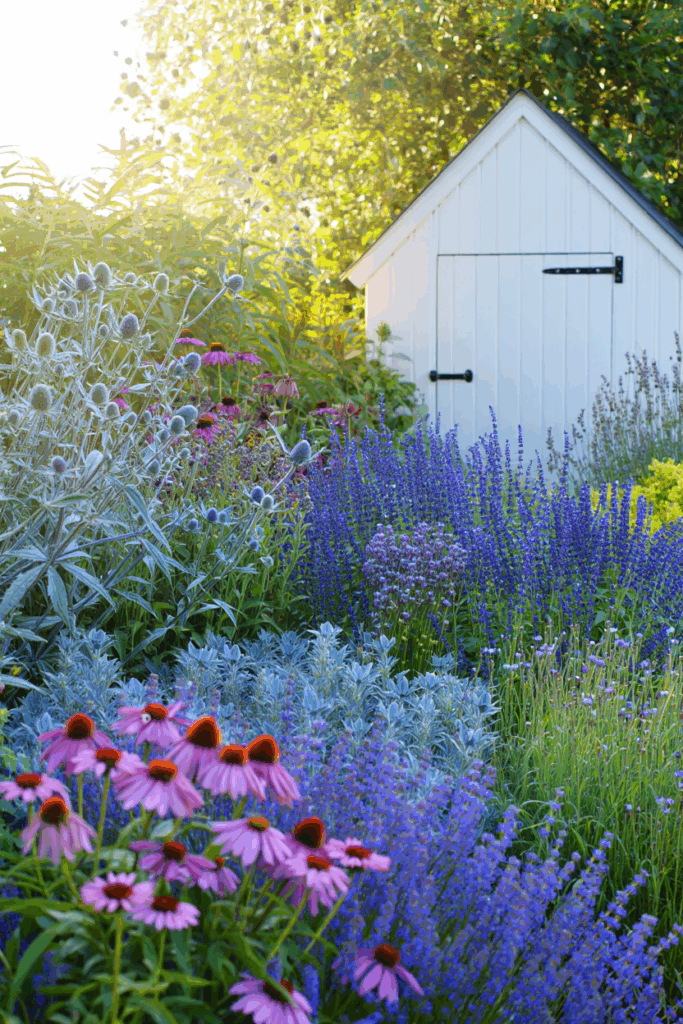
There’s something effortlessly serene about a clean white shed softened by a haze of purple blooms. In this full-sun planting, the cool palette of violet, silver, and blue feels refreshing even on the hottest days. I often start designs like this with structure: a narrow white shed with sharp lines acts as a crisp visual anchor against a billowing sea of texture. For the planting, pair Salvia ‘Caradonna’, Echinacea purpurea, and Eryngium planum (Sea Holly) for height, rhythm, and contrast. Fill in with swathes of lavender—try Lavandula x intermedia ‘Phenomenal’—and silver-frosted foliage like Artemisia ‘Powis Castle’ or Stachys byzantina. The key is repetition and density—mass plantings of just a few varieties to create that immersive, painterly feel. This kind of border thrives in well-drained soil and rewards you with color from early summer through fall, all while drawing bees and butterflies like a magnet.
20: Black-and-White Shed with Peonies and Pavers
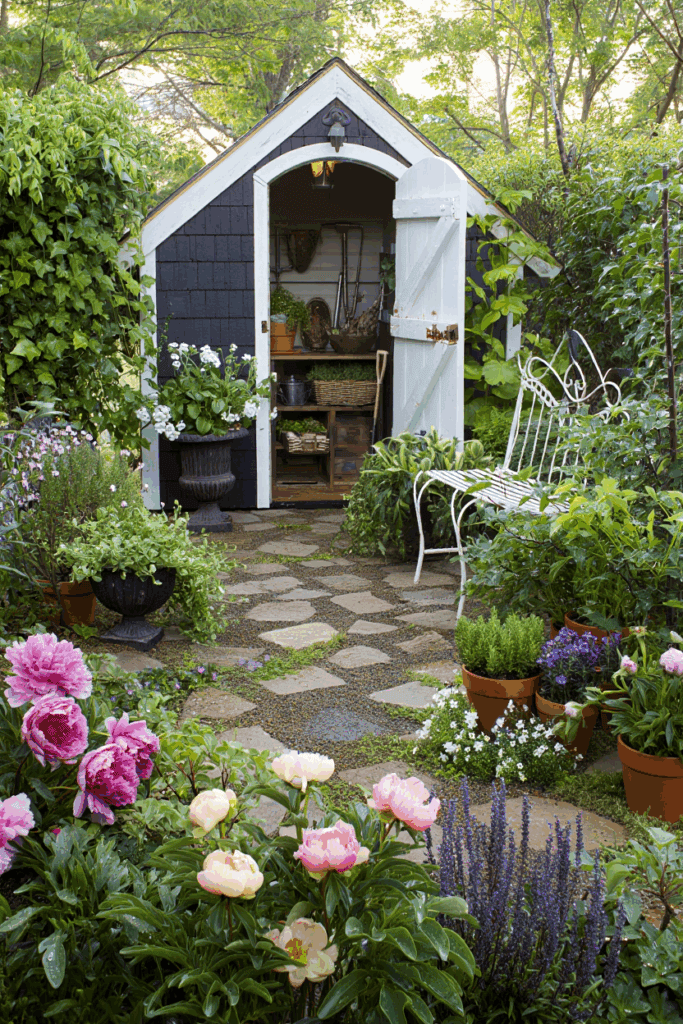
When designing small shed corners, I like to borrow from old-world garden rooms: bold contrast, overflowing pots, and a cozy, lived-in charm. This space centers on a black-shingled shed with white trim—classic, dramatic, and perfect for anchoring lush, romantic planting. The stepping stone path, softened with moss and groundcovers like creeping thyme or Pratia, invites wandering. Along the edge, a generous mix of Paeonia lactiflora (peonies) in shades from blush to magenta pairs beautifully with potted herbs, trailing Bacopa, and white Pelargoniums. Use urns and terracotta to layer height and texture—dark containers near the shed draw the eye in, while lighter tones brighten the front. If you’re creating a similar nook, aim for morning sun and good drainage, and let the seating area feel gently embraced by plants rather than framed stiffly. The result is a space that feels secret, nurturing, and delightfully abundant.
21: Autumn Shed Decor with Pumpkins and Mums
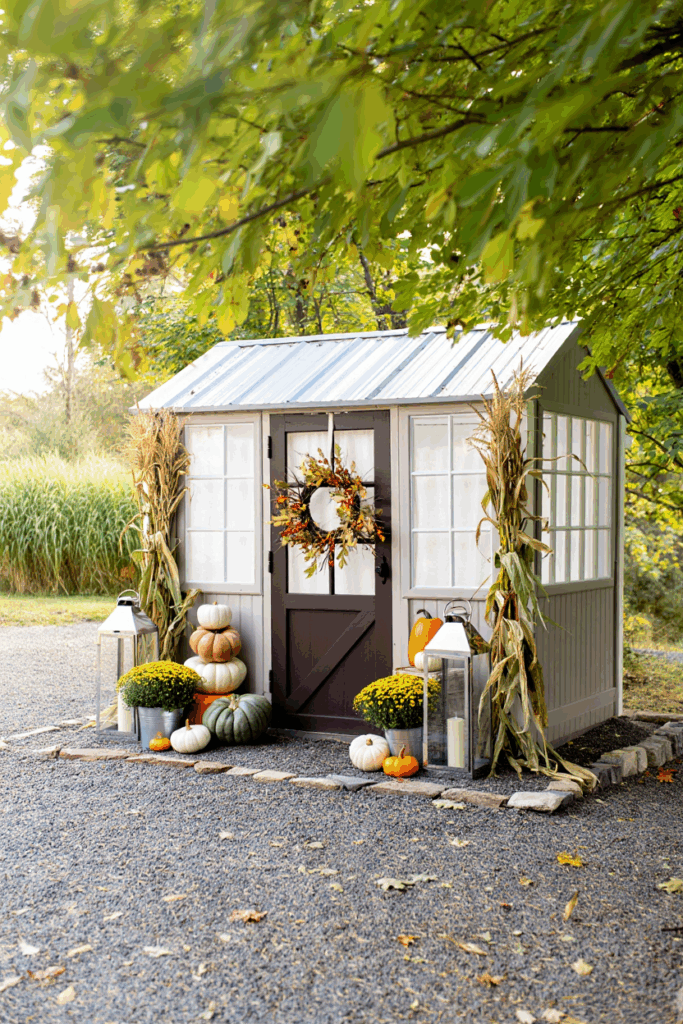
Here, the shed becomes a stage for seasonal storytelling. The design is clean and simple, allowing the textures and colors of fall to shine. A soft greige structure with white-framed windows and a dark door provides contrast and grounding. Cornstalks frame the doorway, drawing the eye up and adding verticality. Below, galvanized buckets overflow with golden chrysanthemums, and stacked pumpkins in all shapes and shades—sage, white, and classic orange—create a harvest palette. For a similar scene, I recommend choosing muted paint tones for the shed that won’t compete with seasonal displays. Stick to natural materials like zinc, stone, and wood for containers and lanterns. Add a wreath made from preserved leaves, dried grasses, or seed pods to carry texture upward. This setup works best at the edge of a gravel driveway or under a tree canopy where dappled light softens the mood and fallen leaves add extra charm.
22: Lavender-Toned Garden Shed with a Calm, Perennial Border
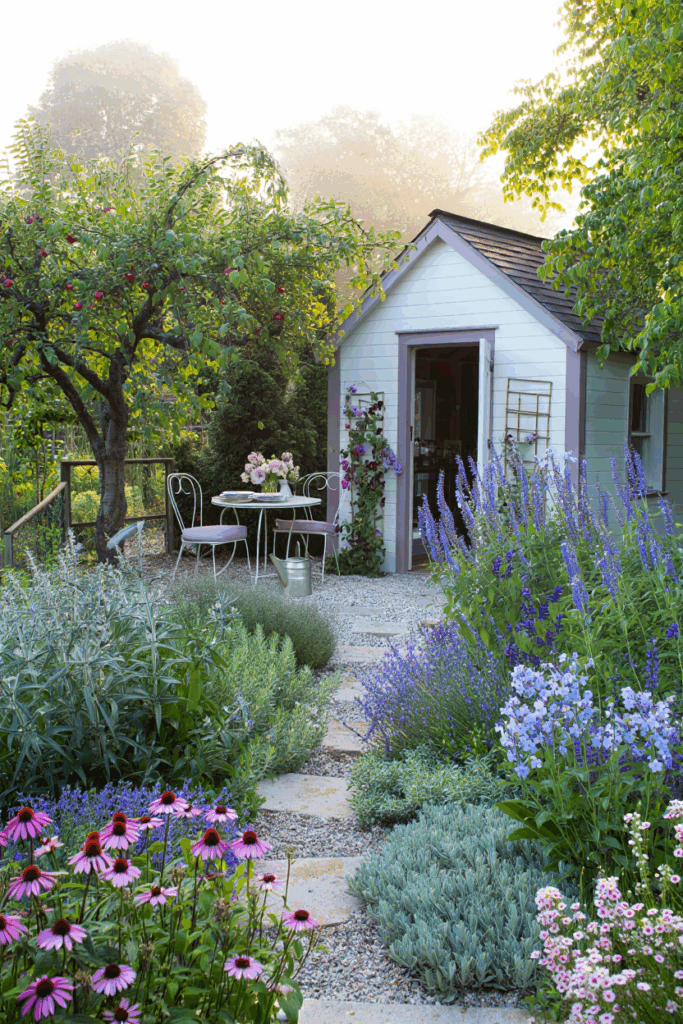
This shed is more than just storage—it’s a sanctuary set into a painterly mix of purples, pinks, and silvery greens. I love working with this type of soft-hued shed because it invites a cooler palette that instantly soothes the senses. To anchor the space, I recommend wide stepping stones set into a pea gravel path—practical, but also visually quiet, letting the plants and shed sing. For the border, start with upright blue salvia (‘Indigo Spires’ or ‘Rockin’ Blue Suede Shoes’) and fill in with lavender (‘Phenomenal’ is both fragrant and reliable), nepeta ‘Walker’s Low,’ and lamb’s ear for that fuzzy, silvery base. I like using low-growing sedum (‘Blue Spruce’ or ‘Cape Blanco’) to edge beds near the door—low maintenance and great texture. The shed wall becomes a backdrop for clematis or climbing sweet peas—anything light and airy to soften the structure.
23: Neutral Shed with Lavender, Hydrangea, and Gravel Path

For a crisp, tailored feel that still feels romantic, I often lean into symmetry and repeat textures. Here, a warm-gray vertical board shed is framed with massed white hydrangeas (try ‘Annabelle’ or ‘Incrediball’) and clipped boxwood mounds for a structure that’s both classic and low-maintenance. Terra-cotta pots filled with lavender, geraniums, and trailing bacopa soften the edges and add movable color. The path is simple pea gravel edged with brick—affordable and timeless. A white trellis gives climbing roses something to lean on—‘New Dawn’ or ‘The Generous Gardener’ are both graceful choices. If you’re designing your own shed vignette, echo these cool-toned greens and whites with one or two blush accents and balance them with structure beneath. It’s fresh, clean, and surprisingly easy to maintain.
24: Cream Shed For Tool Storage

This little cream shed feels like the gardener’s version of a tiny cottage retreat. The curved French doors invite you in, while bundles of dried lavender and open shelving make it feel purposeful yet serene. I always recommend lavender and salvia (‘Caradonna’ or ‘May Night’) for their texture and pollinator power—they thrive near boxwood edging and don’t ask for much. Add antique-style hooks, woven baskets, and a few rustic crates for charm and function. A tucked-away gravel path and soft morning light complete the scene. The key to recreating this look is layering—combine tall bloomers like hydrangea paniculata with loose underplantings like thyme, alyssum, or catmint to soften structure and keep things feeling natural.
25: Red Shed with Climbing Roses and Brick Path

When a shed gets painted red, I like to go all in on warmth and nostalgia. This one, with its cedar shake roof and climbing roses (‘Eden’ or ‘Crown Princess Margareta’) against white trim, feels like something out of a vintage postcard. A layered planting of peonies, lavender, lamb’s ear, and cottage favorites fills the foreground, all anchored by boxwood balls. The curved herringbone brick path adds such wonderful movement—opt for reclaimed brick or tumbled pavers if you’re recreating this look. I love adding rustic tools to the shed door and simple woven mats to blur the line between indoors and out. For color, stick to soft whites, dusty purples, and peachy blushes to complement the richness of red without overwhelming it.
26: Rustic Wood Shed with Corrugated Roof
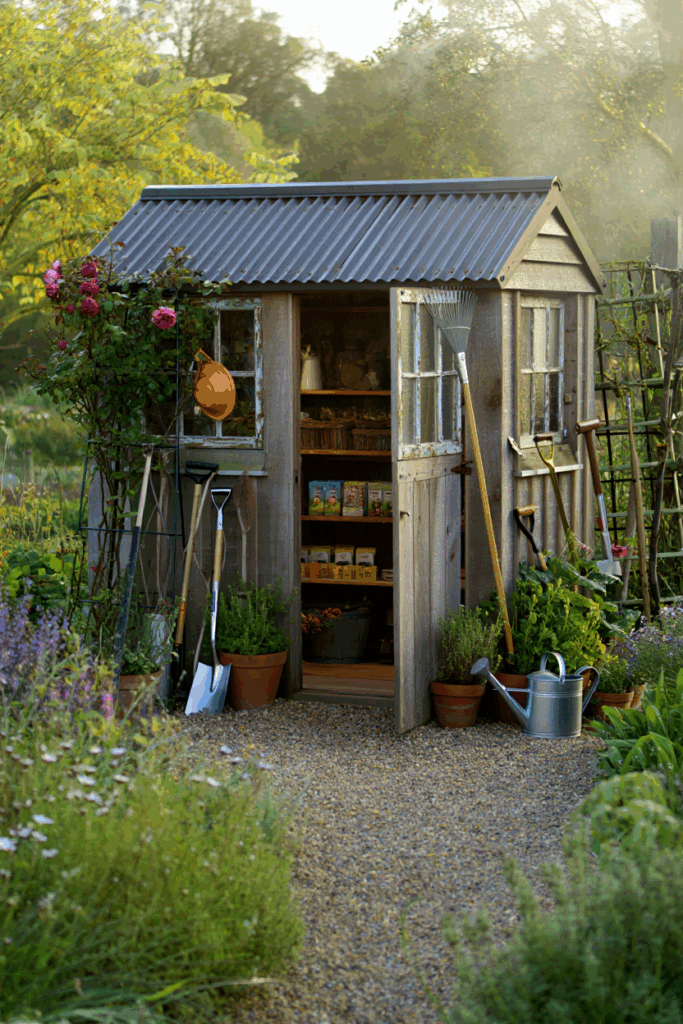
This is the shed I imagine on the edge of a working kitchen garden. Reclaimed windows, a corrugated metal roof, and aging wood siding all speak to utility—but that doesn’t mean it can’t be beautiful. I let things get a little wild here. Tall roses, scrappy trellises, terra-cotta pots full of herbs—especially thyme, oregano, and rosemary—add texture and scent. The trick is mixing structure with softness. Leave the path gravel but frame it with billowing lavender, rudbeckia, and coreopsis. Inside, keep things organized with crates, shelves, and vintage tins. It’s a space where you can dry herbs, sort seeds, and pause with a cup of tea while watching bees do their thing. This shed is proof that the imperfect is often the most loved.
27: Modern White Shed with Mosaic Path and Pollinator Plants
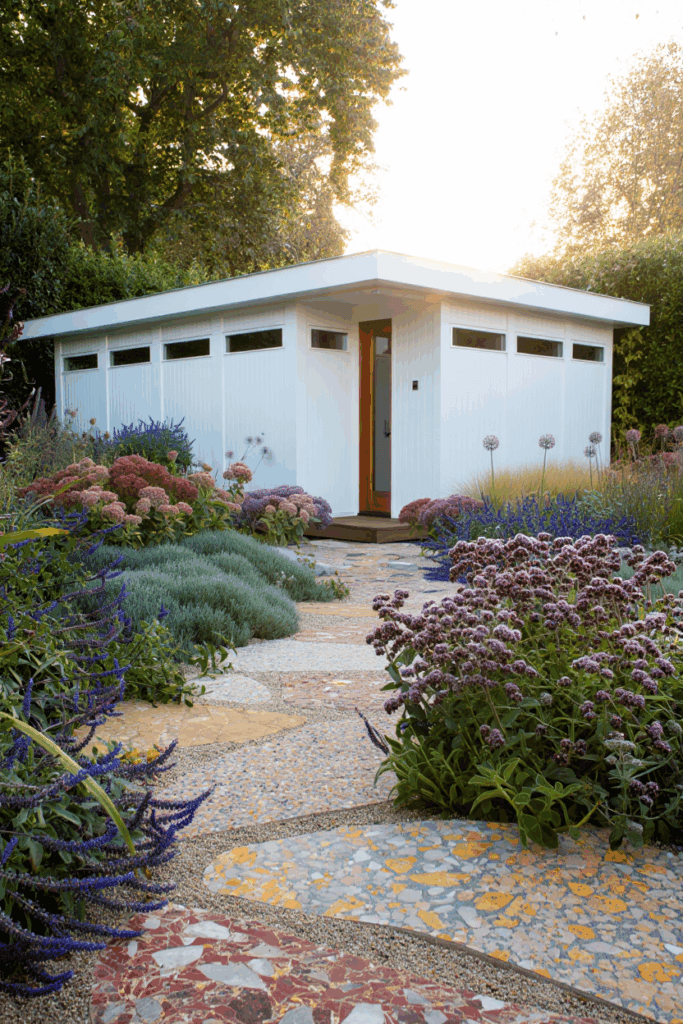
A modern shed calls for bold contrasts and sculptural plantings. The crisp white vertical siding here is softened by the painterly, organic shapes of a mosaic flagstone path—each piece with its own color story. I love using drought-tolerant perennials in this type of design: blue salvia, purple verbena bonariensis, ‘Autumn Joy’ sedum, and ornamental grasses like panicum or pennisetum. Lavender-hued alliums float above the rest, tying everything together. The key here is rhythm—repeating shapes and colors while keeping the palette refined. Let the shed be the anchor, and the path be your visual thread. If you’re designing something similar, start with structure, then let texture and color build out around it naturally.
28: White Shed Framed by Classic Perennials
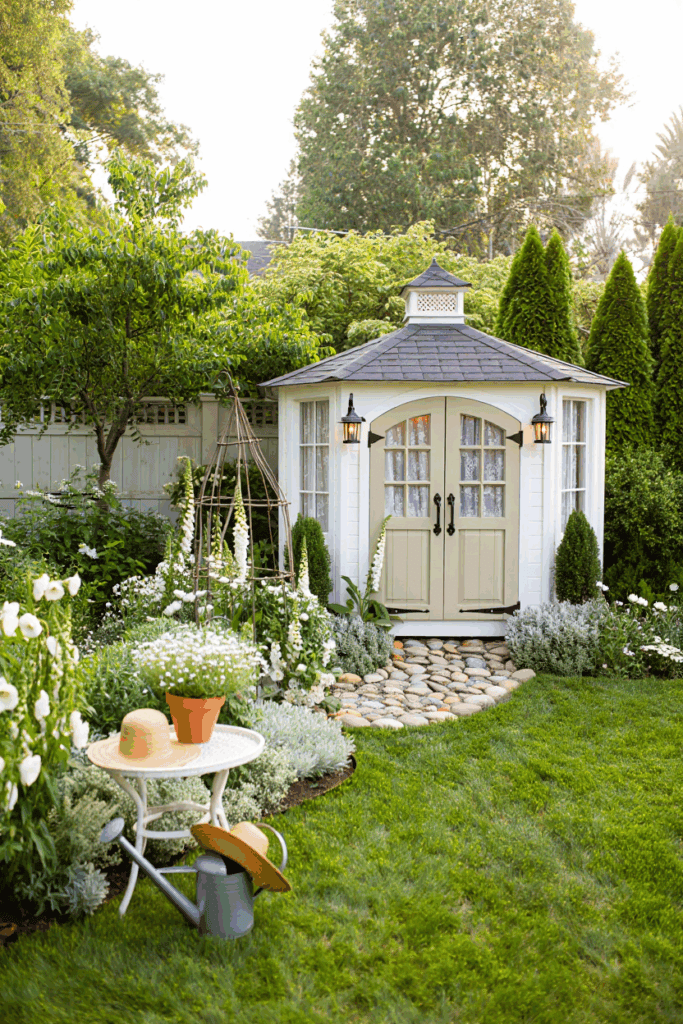
A white garden shed offers a clean backdrop for soft, traditional plantings, letting the textures do the talking. Here, I’d build the base with hardy shrubs like boxwood or ‘Little Lime’ hydrangea for structure. Then I’d add layers—try nepeta or lamb’s ear for low-growing softness, and tall spires of delphinium or phlox for height and color. The design works because each layer supports the next: vertical accents pull the eye up toward the roofline, while lower mounds soften the base. If you’re working with a shed like this, consider painting the door in a pale blue or moss green to add personality without overpowering the palette. This is a timeless look that’s easy to maintain and always feels fresh.
29: Gray Shed with a Tidy Gravel Path and Clean Garden Lines
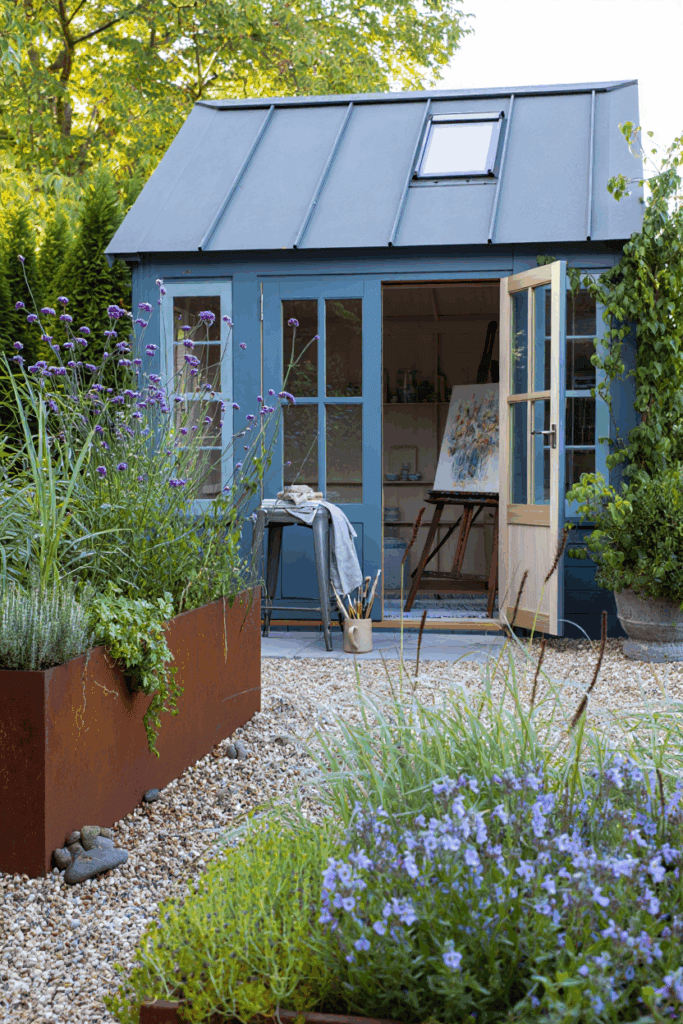
This setup shows how restraint can lead to elegance. The muted gray of the shed blends beautifully with gravel underfoot and evergreen structure on either side. I’d recommend using silver thyme, lavender, or even compact euphorbias along the edges to keep the lines tidy but interesting. Use topiary or clipped evergreens like dwarf arborvitae in containers to bring formality without stiffness. The narrow path guides the eye right to the door, so treat that threshold with care—maybe a simple vintage step-stone or a low trough filled with herbs. Everything here works because the shed is allowed to be the star, framed but never overwhelmed.
30: A White and Silver Garden Border Around a Classic Shed
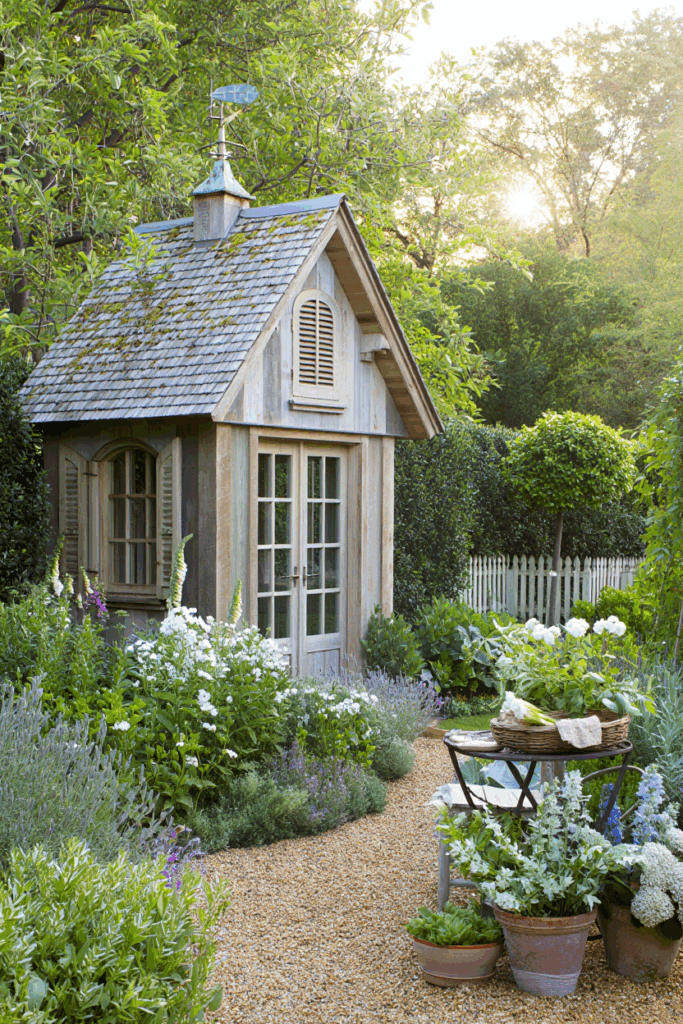

Written By
Amber Noyes
Amber Noyes was born and raised in a suburban California town, San Mateo. She holds a master’s degree in horticulture from the University of California as well as a BS in Biology from the University of San Francisco. With experience working on an organic farm, water conservation research, farmers’ markets, and plant nursery, she understands what makes plants thrive and how we can better understand the connection between microclimate and plant health. When she’s not on the land, Amber loves informing people of new ideas/things related to gardening, especially organic gardening, houseplants, and growing plants in a small space.
